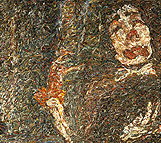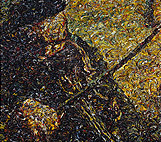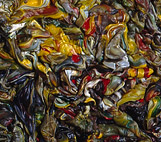Her Life & Work
I.J. Berthe Hess (1925-1996)
Written by Tony Cornwall-Jones
Berthe Hess was born in Paris on 4 November 1925 to Russian parents, Joseph and Chaja Isapow. Her parents, who were prosperous and hard-working factory owners, had four other children, two boys and two girls. She is related to Igor Stravinsky, the composer, and in the case of her father, there is a visible family likeness.
The family lived in Paris in the Rue de Belleville. Maurice Chevalier, the French entertainer and star of the Hollywood hit Gigi, lived close by, as did a child who became a famous singer, Edith Piaf. When Berthe was eight years of age, the family moved to the more prestigious area of Porte des Lilas and it was while they lived there that she came to love and understand Paris, reacting to its influence as if she were an adult and later recapturing its spirit in her paintings of the city.
During the War the house was used by partisans who were coming and going around the clock. Berthe was engaged in delivering messages for them and for Jean Moulin, the Resistance Leader, who she met on three or four occasions. She was twenty-four years of age when she married a British Citizen, Adolph Hess. He was twenty-one and proposed to her at their first meeting. Theirs was a very special relationship.
Berthe Hess had a strong and passionate belief in the spiritual world and had a fund of personal experiences that made the spine tingle. With anyone else, one might suspect fabrication, but not with her. If she had a fault, it was that of speaking the truth in circumstances where prudence should dictate otherwise.
In 1967 the Hesses came to England to open an art gallery. Berthe had been told by a well-known seer that she would open a white gallery, with a huge window, on a corner, next to a large church. Quite by chance, they found themselves in the Paternoster Square development, next to St. Paul's Cathedral, where they were suddenly confronted with a white property, with a huge window, on a corner, next to a "very" large church. They leased the property and called it the BH Corner Gallery.
Hess cannot remember a time when she was without a paintbrush in her hand. She did not have the benefit of a formal art education, but was constantly at loggerheads with her teachers at school, who would only allow her to pain in water colour and insisted that she draw the subject before painting it. Despite the strict discipline in vogue in the schools of her time, she never capitulated and was constantly in hot water.
She was able to hold any scene in memory: people, animals, buildings, vehicles or landscape, and could recreate them in paint many years after the original experience. Largely self-taught, I.J. Berthe Hess (the initials standing for her father's - Joseph Isapow -) slowly developed a truly revolutionary technique. Most artists paint on what is essentially a two-dimensional plane. Hess painted in three dimensions. By that, I do not mean that she used tricks of perspective, or a palette knife, or that she sticks anything to the canvas, or adds anything to the oil paint to give it texture; but that the subject of her painting, the image that her painting projects, hangs in the air between the viewer and the surface of the canvas, both in fact and imagination.
The Times (1969) says of this effect: "... can be appreciated from both an abstract and subject standpoint"... "The artist so welds her colour with form, that a picture emerges, as one looks, from the seemingly abstract surface, often with fascinating effect."
In The Arts Review in July 1968 and again in April 1969, Richard Walker says: "In close-up these paintings are bewildering shredded surfaces of interpenetrating colour"... "One draws back a few feet and the picture changes, becomes in fact a picture... undistorted, but remote, in its own atmosphere."
She grinded and mixed her own pigments, and if you want to know how difficult that is, talk to Windsor and Newton. Using a 00 sable hair brush, the finest available, she laid the paint onto the canvas that she had prepared and stretched herself. By the time she had finished the oil paint is anything between half-an-inch to two inches thick, with as much as an inch-and-a-half between the highest and lowest points of the finished surface. The paint was woven onto the canvas in a series of hillocks of paint. In general, these can be described as having a double curvature, but they vary enormously in size and configuration. In shape the finished surface is like a relief map or model of some tortuous, mad, undulating landscape. Many of these paintings are huge. Taking up to a year to complete, and up to seven years to dry, the weight of each one is enormous!
There are clean lines of colour on the surface of the paint, some of which are transparent, that are finer than the finest brush available, or the finest line that can be applied by air brush. Laid down side by side, these often overlay broader bands of subtly, perfectly graded colour. Despite the thickness of the paint, the finished surface does not display a trace of as much as a single brush stroke or any tool of any sort. The best broad description of the appearance of the colours and the texture of the surface is to liken it to the surface of a piece of moulded glass that is delicately figured with a marbling that has more colours than you have ever dreamed of, or ever appeared in the marbles of your childhood.
In What's On in London, Orwell Blakestone wrote: "The communication is of solid achievement, of beauty analysed and recreated, not just reconstructed. Such is the artist's skill that she seems to be able to tackle any subject with her individual technique." Again, in 1974, he says: "Her painting became richer and more mysterious until it finally evolved into the wonderful walls of colour built with myriads of tiny flecks of paint."
The Sunday Times (1972), Phillip Oakes with Lesley Garner, under the headline Top Berthe in the City, says of her technique, "the surface can be over two inches thick, reflecting colour and light, part painting, part sculpture."
Synthesis, published in the UK, France, Canada and the USA said: "The final image is not a superficial illusion, as in normal painting, but consists of the merging of numerous points of colour and light; situated at different levels."
Buying Antiques said: "Her use of colour is incredible". The way in which the colour is used allows her to use every shade and tone of every conceivable colour; no matter what the subject. Thus she gains all of the advantages foreseen by the painter Seurat (as the result of his study of the science of colour); but without his rigid, mechanistic, carefully planned assault on the canvas. She is able to apply the theory behind Seurat's paintings without ever knowing what it is, in a totally spontaneous, unconscious and free application of paint.
The sum of all these aspects of her technique and her uncanny sensitivity in its application is considerable. The surface of the painting is beautiful in itself, but the total impact can only be described as intoxicating. Each painting is a wonderful optical illusion and they are sometimes difficult to interpret, but like all such illusions, once you have seen the image, you can see every detail and can never shake it off. Art critics have compared her work to the painting of Turner and - unconscious of the family relationship - to the music of Stravinsky. Because the painting does not exist on a flat plane, but is contained somewhere between the high and low spots of the surface, the image seems to hang free. She achieves in a third dimension everything that the impressionists strove for in their study of light, but in addition seems to paint the very air that separates the viewer from the subject. One can almost smell the air and in her painting of The Tripot, you can almost eat the tension. As a result, each painting seems to have a life of its own. One almost expects them to get up and walk about.
In The New York Herald Tribune, the Paris edition, Max Wykes-Joyce referring to her exhibition at the BH Corner Gallery in London says: "A most remarkable exhibition of work... a guardian in the Camargue, emerges radiant in an atmosphere one can well nigh breathe."
The Irish Times (1970), John Fitzmaurice, writer and broadcaster, likens her "understanding of medium" to Rubens and Utrillo. He goes on to say of her technique: "In the final estimate she achieves a strong feeling of atmosphere; an atmosphere that is alive, almost crackling with sensation."
In January 1970 Peter Fuller wrote in The Connoisseur: "A remarkable feature of her work is that she is not content with a general atmospheric interpretation, but captures the minutest details of gesture and landscape and holds them reverberating through inches of paint... The outstanding feature of her work is the discovery of an entirely new way of painting... Sympathy, relish and intimacy so characteristic of French painting simply pour from her work."
In a three-page spread, complete with colour reproductions, Buying Antiques said in a headline: "Her canvases have in only five years become blue chip investments... Berthe Hess has a sense of scale and composition approaching the grandeur of the old masters... Each work reeks with the atmosphere of the subject painted."
No one can say with certainty how the colour is applied: that is a secret that she kept to herself. All those who have advanced theories have been hopelessly wrong, and it is not until you actually try to simulate the technique that you realise that all the normal tools and experience, and just about every means of fabrication and decoration available, together with a good deal of lateral thinking, are to no avail. The people who know the least about painting are always the first to tell you how it is done, while those who know better keep quiet. On one occasion, an artist who was rumoured to be "the most skilled of forgers" told her that it was impossible to replicate. There is no apparent or even vaguely practical means of doing what she does. In 1974 The Investors Review published a full-page article under the headline The Wonderful World of Berthe Hess. In the article, I wrote: "It can never be copied, imitated, or forged; one square inch could not be reproduced even by the artist herself."
Synthesis said: "Her technique is so demanding, painstaking and apparently impossible as to be almost obsessional."
Hess and her husband used the gallery to exhibit her paintings and to promote the work of other artists. Above all, it was an accessible gallery: city typists, show biz stars, art collectors, city bankers, postmen, policemen, writers, artists, sometimes singly, sometimes together, they all dropped in for a chat, for just an hour, or a whole afternoon. I can testify, as can many others, that it was a magic place, where you met and made friends and had fun, more like a club. They ran the gallery jointly until Adolph's death after which Berthe and her daughter continued his work until 1987 when the gallery had to close due to redevelopment. Her permanent exhibition had a procession of famous visitors, which included Prince Charles, Princess Anne, and the French President, Giscard D'Estaing.
At one time she had permanent exhibitions of her work in both London and Paris. She has exhibited in The Museum of Quebec in Canada, in Australia, and several one-woman shows in London, Paris, St Tropez... The painting The Living Christ was exhibited in the Crypt of St Paul's Cathedral and was on public exhibition at Losely House, Surrey, for two years.
Museums from just about everywhere but the UK besieged her with offers of exhibitions. However, the logistics of transporting twenty large paintings, each one of which requires three people to move it, was considerable, and so when her husband died, everything was put on hold, and only a few of these offers were taken up
The only official website designed and developed by the family of I.J. Berthe Hess. Copyright 2013






